
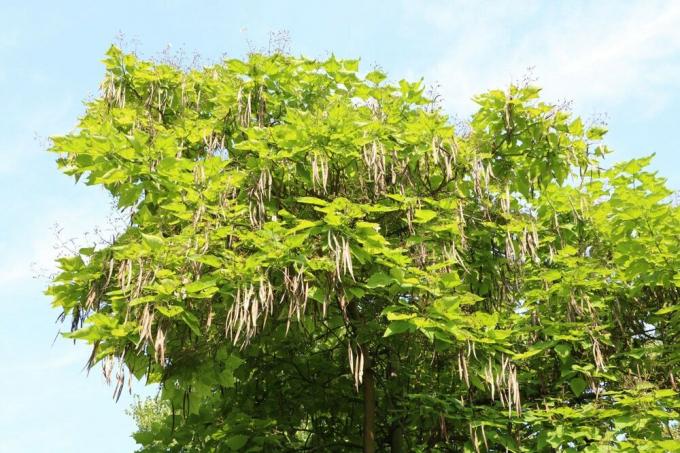
Table of contents
- Short profile
- Happen
- tub culture
- standard
- Care Instructions
- Plant
- plant cutting
- Pour
- Fertilize
- Cut
- Thin out
- Cut high trunk
- multiply
- seed
- cuttings
- hibernate
- diseases and pests
- mildew
- Verticilium wilt
- care mistakes
- Conclusion
In the middle of summer, when other trees are already bearing fruit, the trumpet tree slowly begins to bud. In the middle of June, the huge, up to 30 cm long white trumpet flowers open and provide an absolute highlight in the garden. Unfortunately, Catalpa bignonioides is a little sensitive to frost, which is why the tree cannot be cultivated outdoors in very cold locations. In a wind-protected spot, the trumpet tree enchants not only with its exotic abundance of blossoms, but also with the bizarre fruits that hang from the branches like beans or thin cigars hang down.
Short profile
- botanical name: Catalpa bignonioides
- other names: trumpet tree, cigar tree, bean tree
- Growth height: 15 to 18 meters
- sweeping crown
- Leaves: large, heart-shaped, late budding
- Flowers: 15 to 30 cm long, trumpet-shaped, white, in June/July
- Fruits: long, thin bean-shaped pods
- Root: large, cordate
- deciduous
Happen
The common trumpet tree, botanically Catalpa bignonioides, originally comes from the USA and can still be found everywhere there today. Because of its decorative appearance, it is also popular with us. Not only as a park or avenue tree, but also in private house gardens. While the original species grows up to 18 meters high and is therefore not suitable for every garden, the spherical shape, which is usually available as a standard, remains manageable in growth.
tub culture
Young trumpet trees can also be cultivated in a tub. This is possible as long as a sufficiently large pot can be provided for the tree. When planting in containers, a very high-quality substrate is necessary, so only high-quality ones should be used Potting soil or a mixture of compost (or humus-rich potting soil), garden soil and sand is used become. It is best to first fill in a drainage layer at the bottom of the planter. Since the trumpet trees dry out faster under these conditions and fewer nutrients are available to them, regular watering and fertilizing is important.
Tip:
At some point the common trumpet tree is too big for the planter. Then it's time to plant it outdoors.
standard
A normal Catalpa bignonioides is not suitable for small gardens due to its spreading crown and enormous growth height. The ball trumpet tree as a standard variant is therefore ideal for use in front gardens or small house gardens. This is usually a Catalpa bignonioides 'Nana' with a weaker growth habit that has been grafted onto a trunk. These high trunks come in different heights. The advantage is obvious, because this
Care Instructions
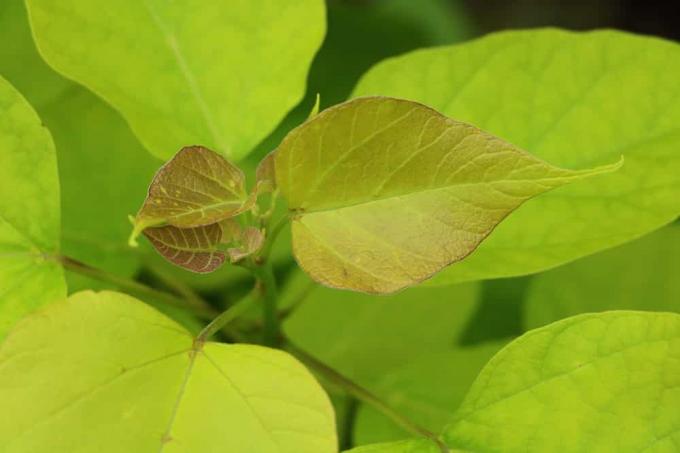
The trumpet tree feels comfortable in the sun and in the light penumbra. Due to its growth height, the tree is ideal for individual planting as an eye-catcher and shade provider in the garden. Since Catalpa bignonioides grows very large with age, the tree must be planted in the ground at a sufficient distance from buildings, property boundaries and also supply lines.
- Light requirements: sunny to light semi-shade
- Soil: fresh, deep
- pH: slightly acidic to slightly alkaline
- sheltered from wind and frost
- urban climate festival
Plant
Since larger specimens of the cigar tree are usually very expensive, everything should be prepared right from the start so that the wood has optimal conditions. In addition to the suitable location, the soil is also very important for the vitality and health of the deciduous tree. The best planting time is in the spring, when no more frosts are to be expected and the temperatures have not yet risen significantly above 20 degrees.
- dig a sufficiently large planting hole
- at least twice the width and depth of the root ball
- in heavy soils, first fill in a drainage layer
- Drainage: gravel or sand (at least 10 cm layer thickness)
- Pour in a mixture of compost, garden soil and sand
- First water the root ball well for a few hours
- insert tree
- Planting depth: as before
- install two or three supports
- Fill the hole with a mixture of humus, garden soil and sand
- incorporate a few handfuls of horn shavings
- show up well
- Tie trunk to supports (with rubber band or sisal)
- water again
plant cutting
Since the trumpet tree needs a few weeks to form new roots and thus establish contact with the rest of the soil, it has It has proven useful to limit evaporation through the leaves a little so that the tree does not dry out immediately after planting dies. To do this, the crown is cut back about a third. If the bean tree is well established, it quickly forms new shoots, which branch out profusely after pruning and ensure a dense growth habit. Trumpet trees do not grow significantly in height, but prefer to grow in width.
Pour
The common trumpet tree has a fairly high water requirement. Due to the countless large leaves, the evaporation rate is very high on warm or hot days, so that the tree has to be watered regularly. It is essential to avoid waterlogging, as it causes the roots to rot. We recommend watering early in the morning so that the soil can dry well. On very hot days it may be necessary to water additionally in the evening. A lack of water is easy to recognize by the limp, drooping leaves.
Fertilize
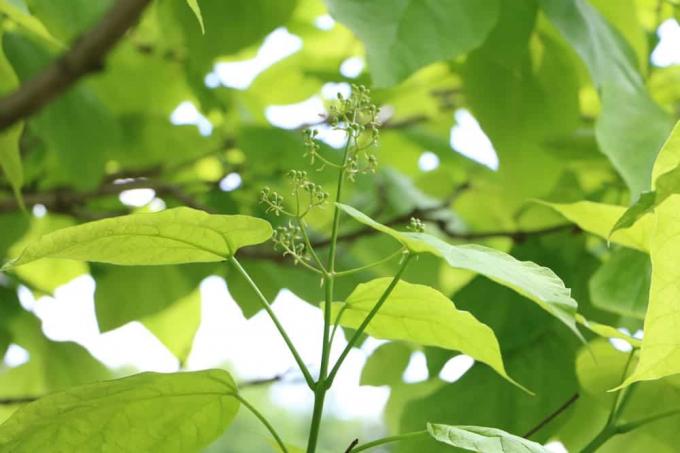
The cigar tree needs a humic and nutrient-rich soil. Since the tree grows relatively quickly, it draws a large amount of these nutrients from the soil. To prevent deficiency symptoms, the common trumpet tree should be fertilized in spring with a slow-release fertilizer such as compost or horn shavings. With larger trees, it is usually a little difficult to mix more compost under the soil, as the roots reach just below the surface of the soil. Here - as well as for potted plants - a liquid fertilizer or a combination of granules of organic and mineral fertilizer is recommended. Mineral nutrients in the liquid fertilizer dissolve very well in water and are therefore quickly available for the trumpet tree. But they are also washed out by the rain and are no longer available. Liquid fertilizers are therefore added at shorter time intervals, around once a month. Combination fertilizers also contain components that are slowly released. Therefore, the fertilizer - depending on the type and manufacturer - usually lasts three to six months. After that, you need to fertilize again. From August you should no longer fertilize, otherwise the young shoots will not be sufficiently frost hardy.
Cut
A pruning or topiary is actually not absolutely necessary for the common trumpet tree. The wood develops its special charm when the twigs overhang loosely in old age. Nevertheless, an annual check is necessary to identify diseased or dead shoots and to be removed promptly so that the bean tree remains vital and protected against diseases is.
- remove dead shoots
- Cut all diseased or withered branches down to healthy wood
- Always ensure smooth, clean cut surfaces
- Remove inward growing branches
- with crossing shoots: cut out one
- Cut all very strong shoots that point steeply upwards (wild shoots).
Thin out
Instead of making radical prunings when the Catalpa binonioides is already too large or overgrown, it makes more sense to occasionally make a thinning cut. The crown is only slightly shortened and excess branches are removed. This ensures that there is always sufficient ventilation in the crown of the tree and it is unlikely that the tree will be bare from the inside.
- Shorten branches by a total of about 10 to 20%
- always cut over a downward/outward facing eye
- remove all branches that grow too densely
- pay attention to the natural growth form
The best time to cut back is in spring, when the weather is no longer quite so damp and cool. Extensive cuts in the fall can mean that the wounds do not dry well and pathogens can penetrate. Pruning is always done on a rain-free, cloudy day with moderately warm temperatures.
Cut high trunk
Although the trumpet tree can also tolerate quite radical pruning, these are generally not necessary. The crown of ball trumpet trees, which are cultivated as a standard, quickly lose their typical round shape if they are carelessly pruned. Slightly shortening the shoots and removing diseased or dead wood is usually sufficient. It is much more important with grafted plants that wild shoots that come from the rootstock are removed promptly. In the worst case, the rootstock will overgrow and repel the grafted plant.
- radically cut away any branches growing out of the trunk
- never shorten the crown completely
- leave at least two buds per branch
- Thin out only slightly and possibly correct the spherical shape
- remove diseased and dead wood
multiply
The cigar tree can be propagated by seeds and cuttings.
seed
Ripe seeds can be removed from the long, bean-shaped seed pods in autumn.
- Sow: in spring
- Soak seeds in water for 24 hours
- Substrate: potting soil, cactus soil
- Cover seeds with fine sand
- Temperature: 18-23 degrees
- partially shaded location
- Germination period: 5-8 weeks
cuttings
Slightly woody cuttings can be taken from the trumpet tree in early summer.
- Length: 10cm
- remove lower leaves
- Scrape the bark off the bottom (2 cm)
- Substrate: moist cactus soil or potting soil
- place in semi-shade
- keep slightly moist
- Temperature: 16-20 degrees
hibernate
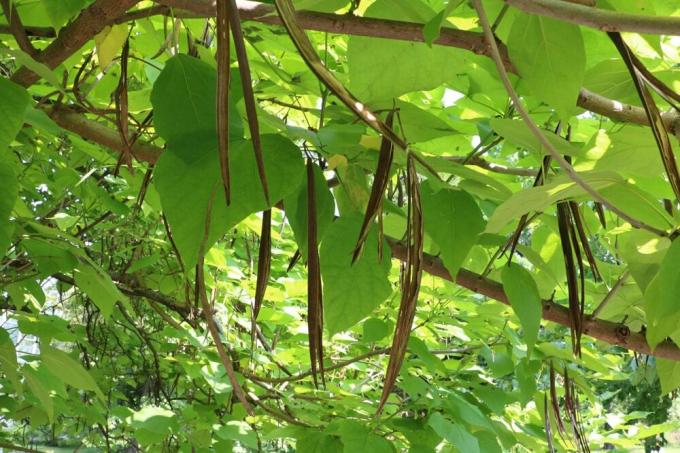
The trumpet tree does not tolerate freezing temperatures and cold winds very well, so it should be protected - especially when young. A good location already contributes a lot to survival. In addition, the following measures should be taken:
- Cover roots with a thick layer of brushwood, leaves, or mulch
- attach a windbreak in draughty places
- Young trees: wrap fleece or mat around the trunk and fasten with wire
- in spring the flower buds must be protected from late frosts
- to do this, the tree can be covered with fleece at night
- remove the fleece again during the day at moderate temperatures
- Overwinter potted plants in a cold house
- Frost-free garages, unheated conservatories or greenhouses are suitable as winter quarters
- never hibernate warm
Tip:
Anti-freeze measures never hurt, even if it's not as cold as expected. It is therefore better to have too much than too little protection.
diseases and pests
The robust cigar tree is largely resistant to pests. Should aphids or other parasites appear, this usually does not pose a significant threat to the plant.
mildew
If the weather conditions are unfavorable, for example in a very cold and damp spring, powdery mildew can spread to the bean tree.
- collect fallen leaves
- Cut out affected shoots
- Dispose of in the household waste (do not throw in the compost or in the organic waste bin)
- From now on only water the tree in the morning
- fertilize sufficiently to increase the body's defences
Verticilium wilt
Since the fungus invades and clogs the ducts of the wood, the supply of nutrients and water is interrupted. The disease can be recognized by the fact that whole branches suddenly die off, while all other parts of the plant continue to grow normally and vigorously. Unfortunately, there is no effective pesticide against this fungus, so the infestation must be detected early to protect the trumpet tree from certain death. When the first symptoms appear, all diseased branches must be cut back down to healthy wood. Waste must not be thrown in the organic waste or on the compost, otherwise the wilt will spread throughout the garden.
care mistakes
Sometimes there are early signs that something is wrong with the trumpet tree. This does not always have to be a bad illness, it is often due to the fact that the wood is not properly cared for.
- very light leaves: the tree suffers from a lack of nutrients, a good NPK fertilizer with trace elements will remedy this after just a few days
- withered leaves all over the tree: if the tree is too wet, root rot can occur, which often means the death of the plant
- Leaves droop limply: water urgently, the cigar tree lacks water
Conclusion
For mild locations or a sheltered location, a trumpet tree is a wonderful addition to the garden. Anyone who does not have enough space for the normal form of Catalpa bignonioides can fall back on a standard tree that is no longer significantly higher, but only grows in width. However, the tree needs a lot of water and occasional fertilization in warm, rainy times. Otherwise it is easy to care for, apart from the insufficient frost hardiness.
 garden editorial
garden editorial I write about everything that interests me in my garden.
Learn more about potted plants

Spider Flower, Cleome hassleriana: Care Instructions
Spider flowers get their name from their spider-like appearance. Many hobby gardeners shy away from cultivating the beautiful exotic species. When it comes to maintenance, there are just a few things to keep in mind.

How do I care for a gentian tree? Lycianthes rantonnetii
A gentian tree can be a decorative enrichment both on the balcony and in the garden. For the culture, however, some criteria must be observed. This includes, among other things, the high nutrient content that is required for flowering.

Overwinter pampas grass | 16 tips for winterizing
Pampas grass is a popular ornamental plant in the garden or in tubs, which can be attractively integrated into a wide variety of garden ideas thanks to its decorative fronds. They are considered hardy, but need suitable winter protection in Central Europe due to possible moisture damage.

Leadwort, plumbago: care from A to Z
Leadwort (Plumbago) hides one of the most attractive potted plants of all. The magnificent shrub impresses above all with its blue flowers, which it produces from May to autumn, transforming terraces and balconies into a luminous oasis.
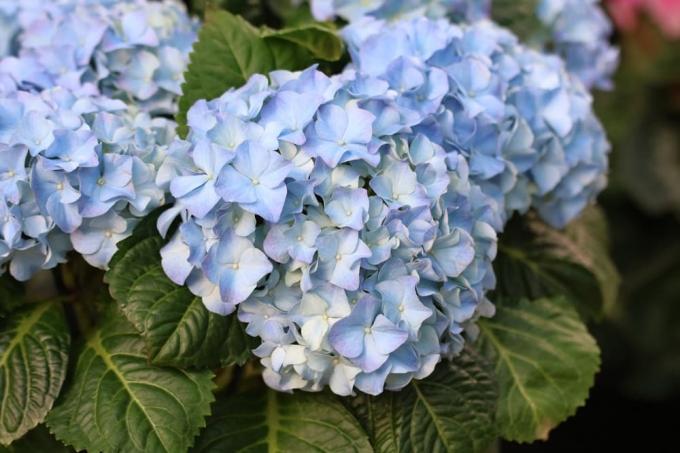
Hydrangeas, rhododendrons and hibiscus smoke | dangers of drugs
Anyone who has cultivated hydrangeas, rhododendrons or hibiscus in the front yard may be surprised that the beautiful flowers were cut off by strangers. Because especially among young people, there is a rumor that these flowers can be smoked and have the effect of marijuana. But this is dangerous information.

Peasant hydrangea, Hydrangea macrophylla - care and pruning
With its attractive, ball-shaped umbels of flowers in white, pink, purple, red or blue, the hydrangea is one of the most decorative garden plants. Here's what you need to know about the farmer's hydrangea so that it blooms and thrives lushly in your garden.


